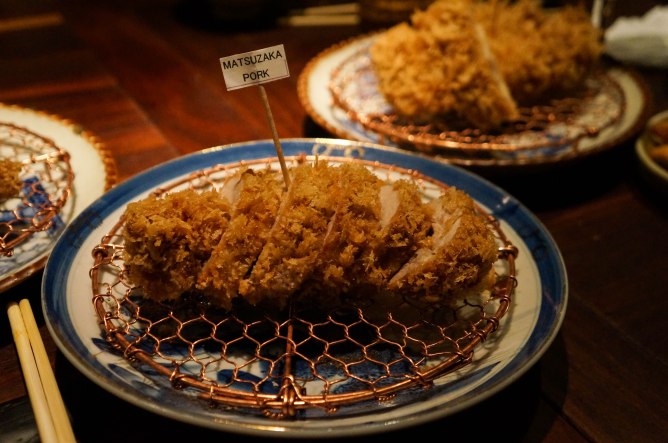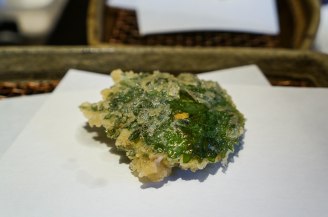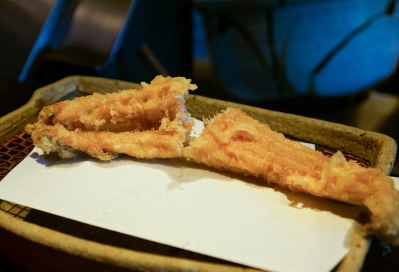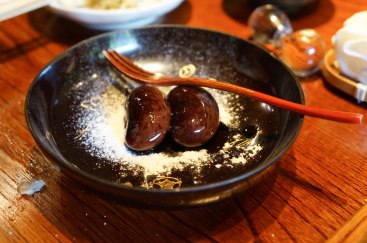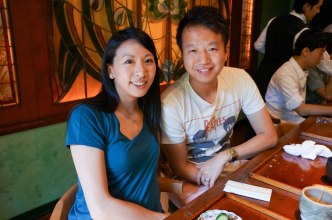I absolutely love pork. It comes second to none for me. If I had to quick fire my favorite foods off the top of my head pork would be in a lot of them. One of those would undoubtedly be tonkatsu (deep fried pork cutlet). Breaded, deep fried, with Worcester sauce over on rice. Sublime. When Tina and I were in Japan, despite more than a few reservations at michelin star restaurants, I was most excited about this meal.
Chef Oishi started his culinary career in a tonkatsu shop. He went on to be involved in French cuisine for some time before returning to Japan in 2005. His love and knowledge of pork developed over the years led him to opening this restaurant that is solely dedicated to pork. You will find no other meat at Butagumi. After all buta, Japanese for pork, is in the name.
In fact, “The ultimate tonkatsu can be found here” is the heading of Butagumi’s about page. Oh yes. Music to my ears.
Butagumi’s tonkatsu is deep fried in their independently developed “sesame based” oil, breaded with “top grade panko aged for 4 hours” as opposed to the industry standard “second grade panko aged for an hour”, and drizzled with their original blend of “sun sauce”. This is straight from their website roughly translated by yours truly. I’m not sure what half of it means, but it sounds provocative.
During our honeymoon, we had two couples join us for this part of the trip. The six of us formed some kind of tonkatsu tasting squad. The restaurant is a good 20 minute walk from the Roppongi train station. Off the main streets in the midst of a residential neighborhood in a traditional looking building. On the exterior is a crescent moon carved out on the wall. The inside was very cozy and homey with various cute pig themed decor. My kind of place to have a good meal.
The menu presented to us was overwhelming to say the least. I had never seen a menu as extensively devoted to different types of pork. It is roughly divided between rosu katsu (pork loin) and hire katsu (fillet). Each further divided into light tasting, flavorful, rich flavor and super rich flavor pork. The list of pork changes depending on availability. Each cut of pork had a brand name attached with a short description of which region in Japan it came from.
There must’ve been 40+ choices on that menu. You can imagine it took us quite a while to sift through all of the options. One might think to have 3 cuts of each rosu and hire katsu in different flavor grades to try a variety. However, we did not do that. If you know anything about tonkatsu it would be that rosu katsu is usually the more desirable cut because of it’s fat and juicy nature. Hire, while still good in taste is on the leaner side. We opted for 4 rosu katsu and 2 hire katsu.
The only let down was that Iberico (Spanish pork) wasn’t offered that night, but our waitress suggested another Japanese cut that was comparable. Missing it wasn’t ideal since Iberico jamon is my favorite Spanish food, but there were plenty of options for delicious pork on the menu.
Aside from the tonkatsu, we also ordered some appetizers, beer and plum wine for the table. Great food should be enjoyed with great friends, and that night’s atmosphere was fit for serious acts of gluttony.
We ordered tomatoes, broccoli, and eggplant for appetizer. Among them the tomatoes were especially tasty. The eggplant was very good too. So good I forgot to snap a picture until there was a single piece left! Each pork entrée was also accompanied with miso soup. I would recommend getting some appetizers to share in a group, but like I said before, this place is all about the pork.
First up is Tsunan buta from… well Tsunan city in Niigata prefecture. A rich flavored hire katsu. Flavor wise was decent compared to the rest, but it was predictably leaner than what most of us liked. Still, being the first piece this was a very good sign of things to come. The panko breading was significantly better than anything I’ve had state side. Very crusty but not too flaky. One point of comparison for me would be Maisen Tonkatsu in Shibuya. There, the panko was very flaky. This is a matter of preference, and I liked both but preferred Butagumi’s style of panko breading overall.
Ryuuka ton hails from Okinawa and is a light tasting rosu katsu. Coming from Tsunan buta it was immediately obvious that a bit of fat is desirable in a tonkatsu. Among rosu katsu though, this was my least favorite. Keep in mind it’s relative to the others we tried. It’s still a very good piece of pork.
Matsuzaka pork is a cut from a pig that is originally from China but bred in Mie Prefecture in Japan. It’s name is derived from the same name of the slaughter house that packages them. It’s listed as a flavorful grade of hire katsu. From memory this tasted the most like cuts of kurobuta pork where it was chewy and juicy. Definitely the better of the two hire katsu.
Himuro buta from Isesaki city in Gunma prefecture is a flavorful graded rosu katsu. This was a favorite among the girls unanimously. It came second for me, but I did agree with the others that this had a perfect balance of taste and fattiness. Upon further research, this himuro buta is dubbed as the “ice room pork”. The description states that it is aged in freezing temperature where the pork’s amino acid content increases resulting in a soft texture and sweet taste. I’ll just chalk it up to “because science”. Apparently, Butagumi is the only restaurant in Tokyo that serves this particular cut of pork.
Rich flavored rosu katsu. From Gifu prefecture, Nattoku ton was the closest to the ideal pork for tonkatsu found upon the opening of Butagumi. It’s cited as “Butagumi’s No. 1 brand pork”. From memory this was like the Himura buta but fattier. Some of the pieces had chunks of fat, but overall this was very very solid.
Nakijin Agoo buta is another Okinawa rosu katsu in the super rich flavor classification. This is a cut from a once very rare island agoo pig that was successfully bred in recent years. This was the very cut recommended that is most similar to the Iberico. In fact, Butagumi customers have reported to have said that this is better than the Iberico. It is widely considered as the “rival to Iberico” and touted as Japan’s most flavorful pork. This was easily my favorite due of the immense amount of flavor and juiciness. First bite in and I knew I was in love. This was like tasting wagyu for the first time. Mega rich in flavor and on the limit in fattiness. The girls all found it too fatty and overwhelming in taste. I think like wagyu, this too should be had in modest quantities.
Between the 6 of us, 4 picked Himuro buta as their favorite, while the other 2 including myself ranked Nakijin Agoo buta the highest. While I tend to suggest my personal picks only as reference, in this case I think these two would be must haves for anyone dining at Butagumi. I wouldn’t hesitate to order them again.
As I sip on a beer at the end of the carnage discussing the food with my foodie friends, I found myself with the widest grin across my face. Being a piggy lover, this was nothing short of a meal of my dreams!










